Cover image: Kayla’s Music Box by Aaron Miller
Good morning all and welcome back to the Mirror Gallery here on Hipsters of the Coast! It may seem like we’ve only just done a Grand Art Tour, but as war rages on across Dominaria, so too does our critical eye on the art that chronicles this saga. Today we’ll explore the latest set, The Brothers’ War, and see exactly what this conflict has brought to the cards by way of narrative storytelling.
If you’re new to the Grand Art Tour series, it’s my review column begun back in 2019 and inspired by New York Magazine art critic Jerry Saltz’s 2010 article entitled A Grand Tour. That article focused on Saltz’s favorite paintings from around the city that summer, and these articles do the same, substituting museums and exhibitions for MTG main sets and Commander releases. We’ll look at some of my favorite pieces, why I think they’re important, and highlight elements you can’t see just by looking at the cards.
While The Brothers’ War set is artistically broken up into three Acts, essentially before the war, during the battle, and post-conflict, the Grand Art Tour from this set will mix and mingle pieces from across the story, and relegate Act structure aspect to a future article. While these pieces work together to tell a longer narrative, each individual work does an exceptional job of telling the micro-fiction that make up the larger story, and that’s what I want to focus on today.
And so, we go to war. This is The Brothers’ War Grand Art Tour.
Calamity’s Wake by Slawomir Maniak
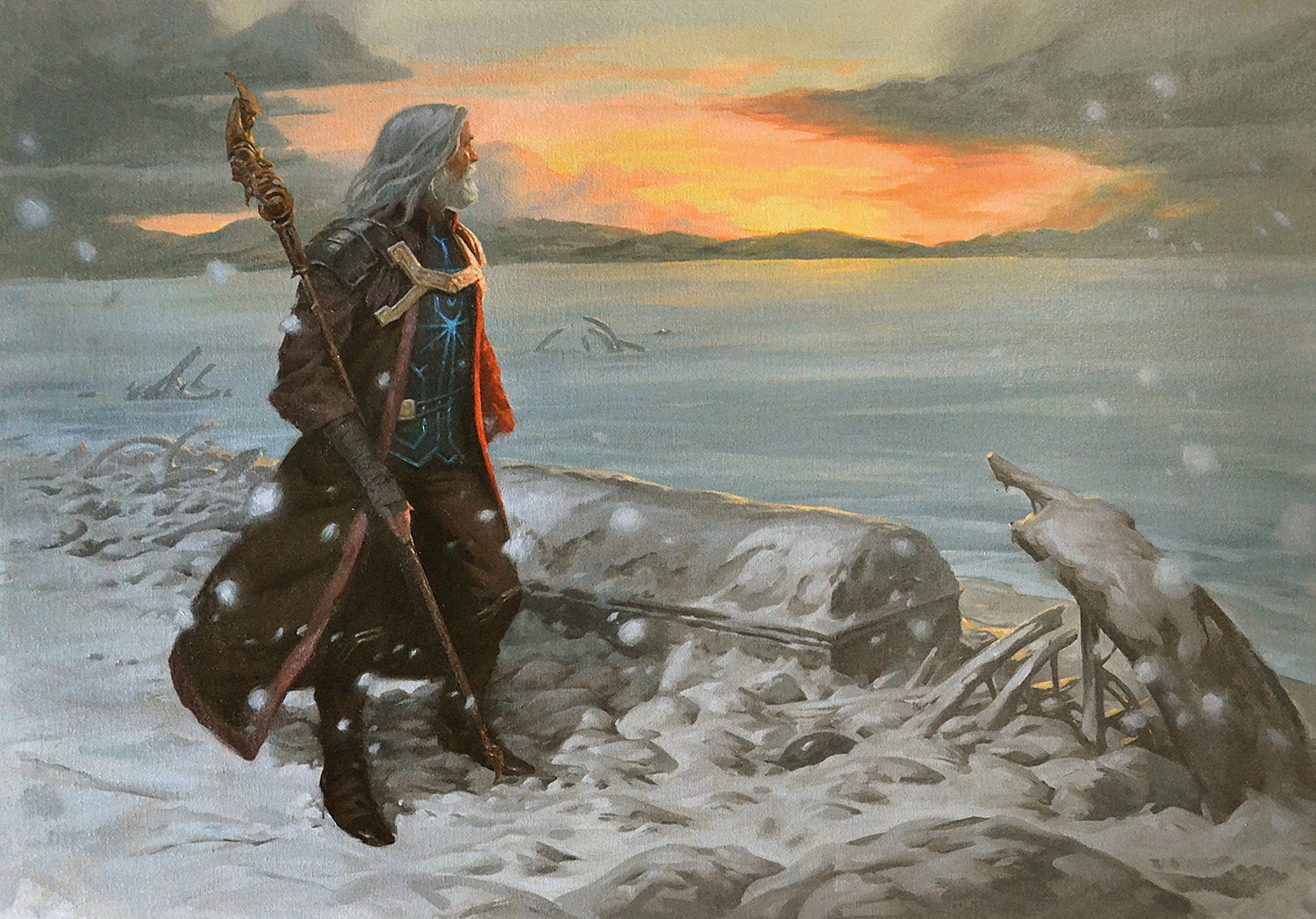
Calamity’s Wake by Slawomir Maniak, oil on canvas on wood, 19.7” x 27.6”
We’ll begin with the end: this is Calamity’s Wake. We see Urza overlooking the battlefield of Argoth in the moments following the detonation of the Golgothian Sylex. There is such a solemnity to this work, as the now-Planeswalker looks out across what he’s done, and the first flakes of snow fall in the foreground. We can feel the weight of his actions on our own shoulders, and that is no easy feeling to capture in two dimensions. Maniak only recently started working traditionally for Magic, and what a treat it is to be able to hang his imagination in your home.
Kayla’s Music Box by Aaron Miller
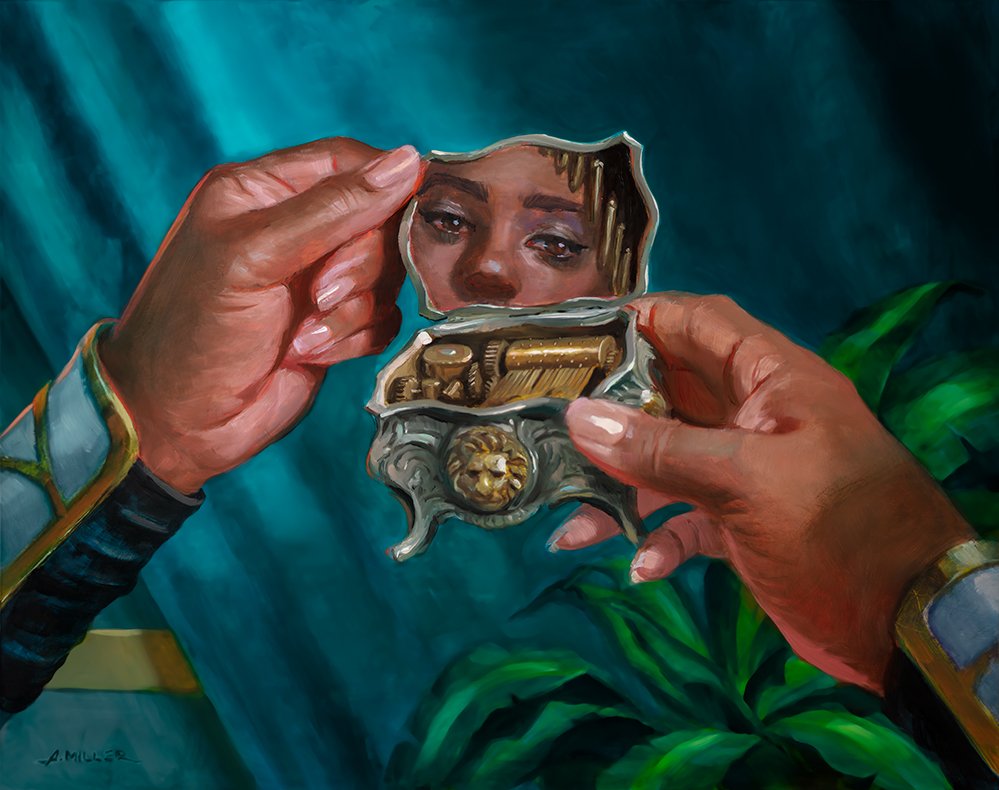
Kayla’s Music Box by Aaron Miller, oil on aluminum panel, 11” x 14”
Kayla’s Music Box is one of my favorite pieces across the entirety of this set, and appears in the Old Border within the Urza half of The Brothers’ War Commander decks. Miller shows us that there are more than three people who can paint hands in Magic, and we get a beautiful and somber reminder of the relationship between Urza and Kayla bin-Kroog.
The flavor text tells more of the story, but in short, this music box is the physical representation of Urza’s feelings toward the princess that would become his wife. You can see it in her eyes in the reflection, and even feel it in the way she’s handling the box. This is an incredibly powerful image, and though only a small part of the larger story, is larger than life in and of itself.
As an aside, the Reddit post where I found the story passage points out the flavorfulness of this ability—you wind it up, and can play with what you “wound.” How cool is that?
Sanwell, Avenger Ace by Josu Hernaiz
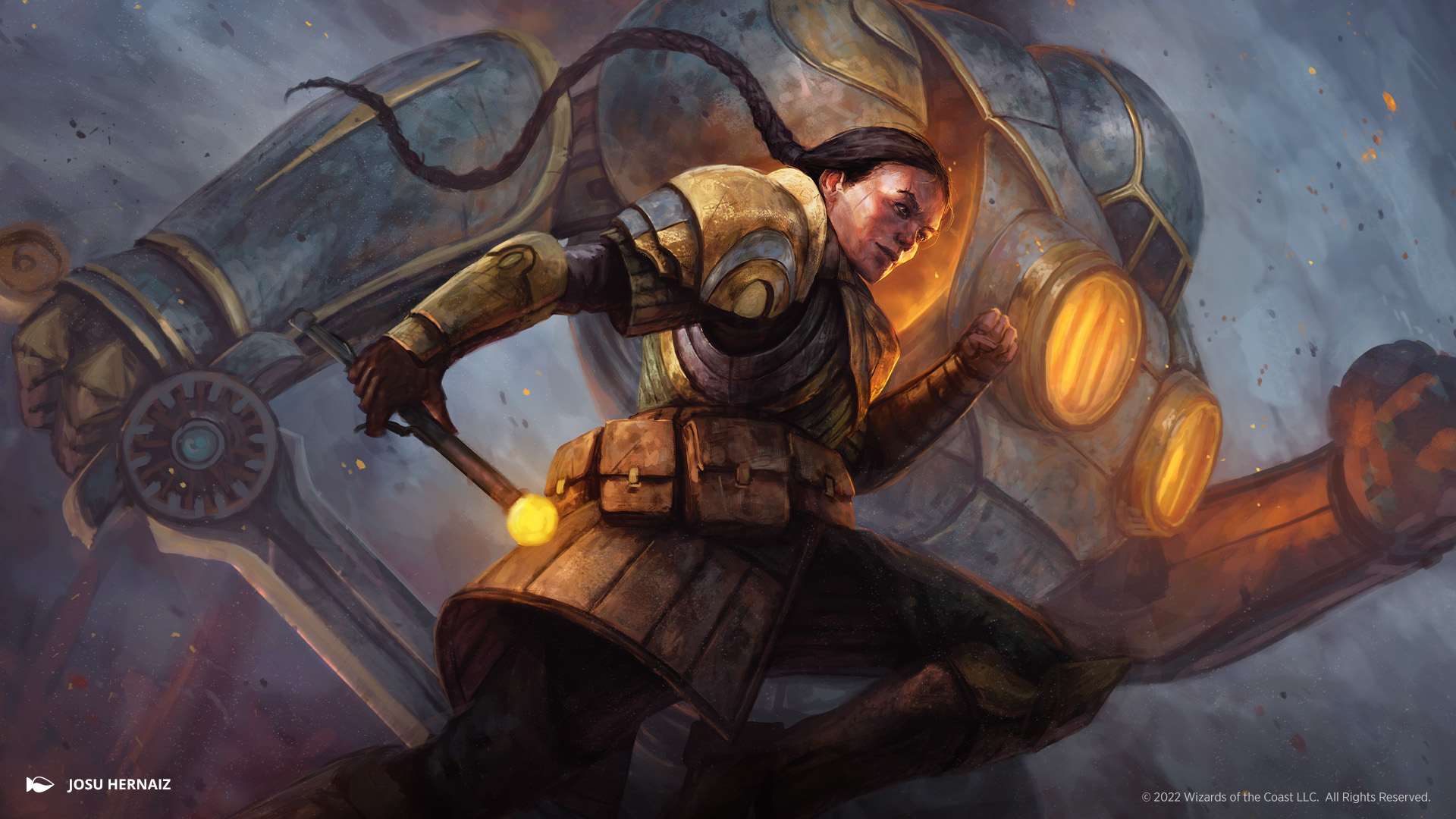
Sanwell, Avenger Ace by Josu Hernaiz. Digital.
Wizards Loremaster Jay Annelli spoke about this image over on CoolStuff Inc. in his article “The Weapons of the Brothers’ War”; we see an Urza Avenger being controlled by the legendary Sanwell using a control rod. There are major Pacific Rim vibes here, and while I don’t often reference pop culture relationships, it would almost be disappointing if a set full of giant mechs controlled by humans didn’t have a few callbacks. I love the parallel composition, showing humans and machines working in tandem. Sanwell, Avenger Ace would make for a fun and flavorful Commander deck, allowing you as a player to take control of the rod and your own mechanical army.
Wondrous Crucible by Evan Shipard
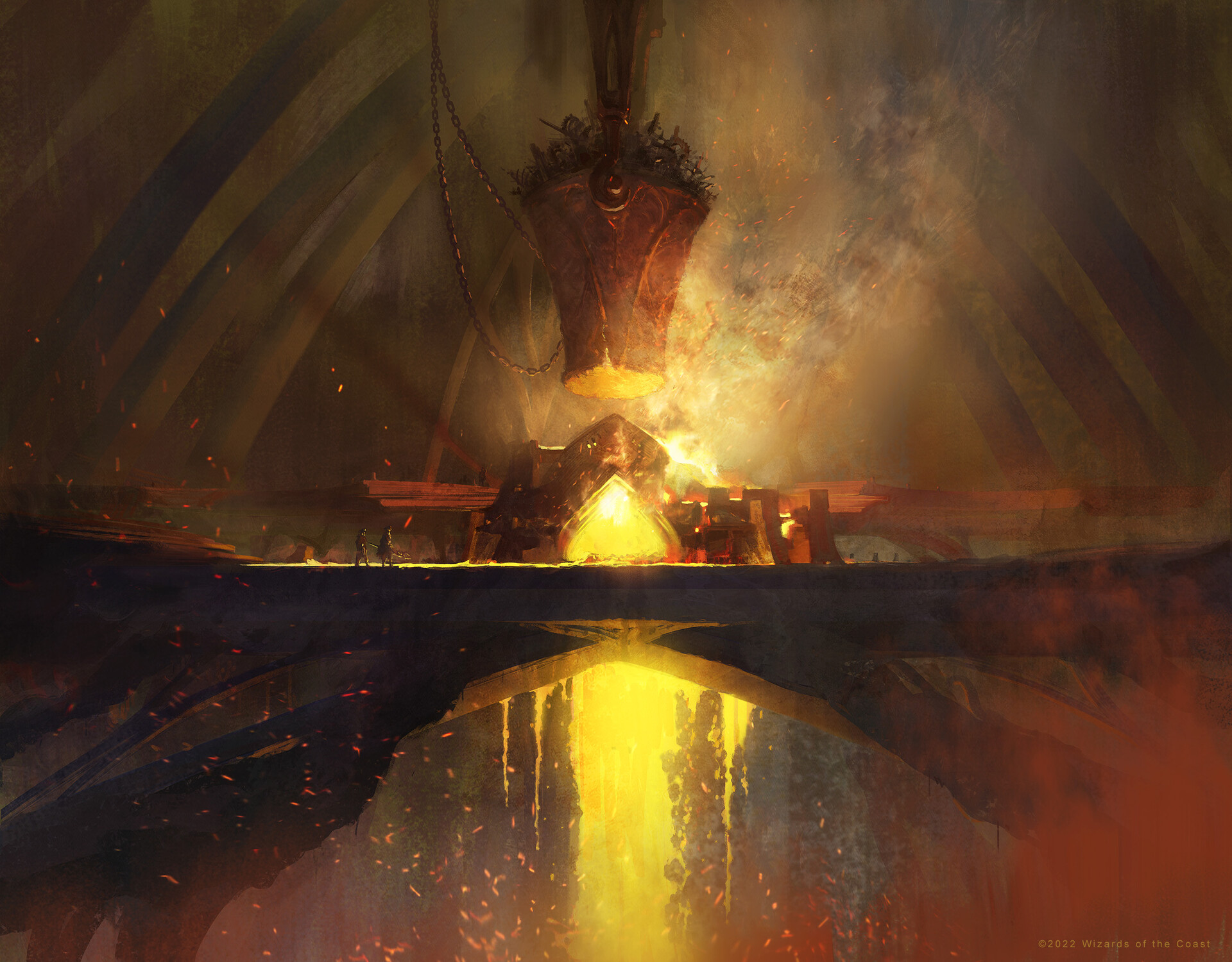
Wondrous Crucible by Evan Shipard. Digital.
I love Shipard’s work, plain and simple. His illustrations are as if JMW Turner had come to Magic, and when I saw this piece, I emailed Ev to make sure the artwork would be available in time to include. Smoke and spark reveal the Wondrous Crucible deep within a cavern somewhere along the battlefield, familiar but also unknown. The crucible itself draws our eyes and spreads outward, allowing us to explore the image entirely. It’s reminiscent of Tolkein fantasy while being wholly unique to contemporary Magic, something old and yet brand new.
Desynchronize by Rovina Cai
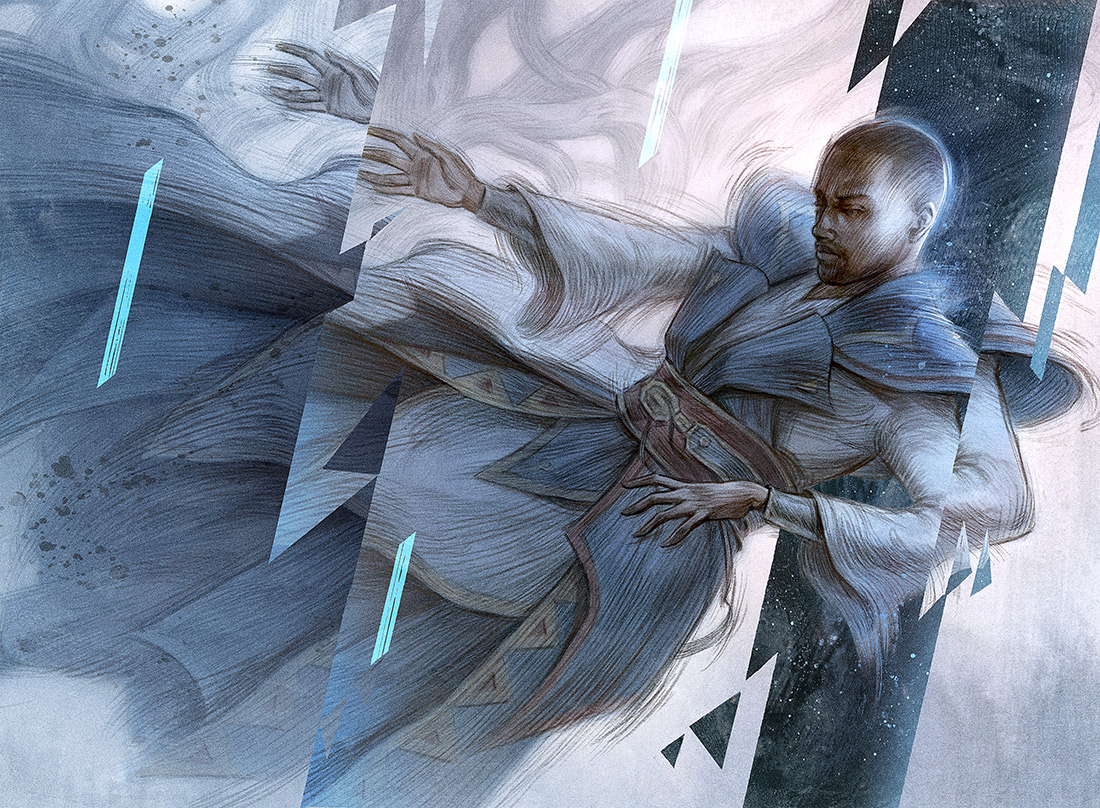
Desynchronize by Rovina Cai. Digital.
Rovina’s work always moves us from the concrete to the abstract, as she’s able to capture a rare bit of surrealism within the broader genre of imaginative realism. In Desynchronize we see Teferi literally fracturing in time and space as he hurls through the temporal anchor; It is impossibly difficult to illustrate the ideas of “time magic” yet she’s able to legibly convey what’s taking place. It has gravity and seriousness, and we’re left on the edge of our seat as he balances on his.
Dreams of Steel and Oil by Jeremy Wilson
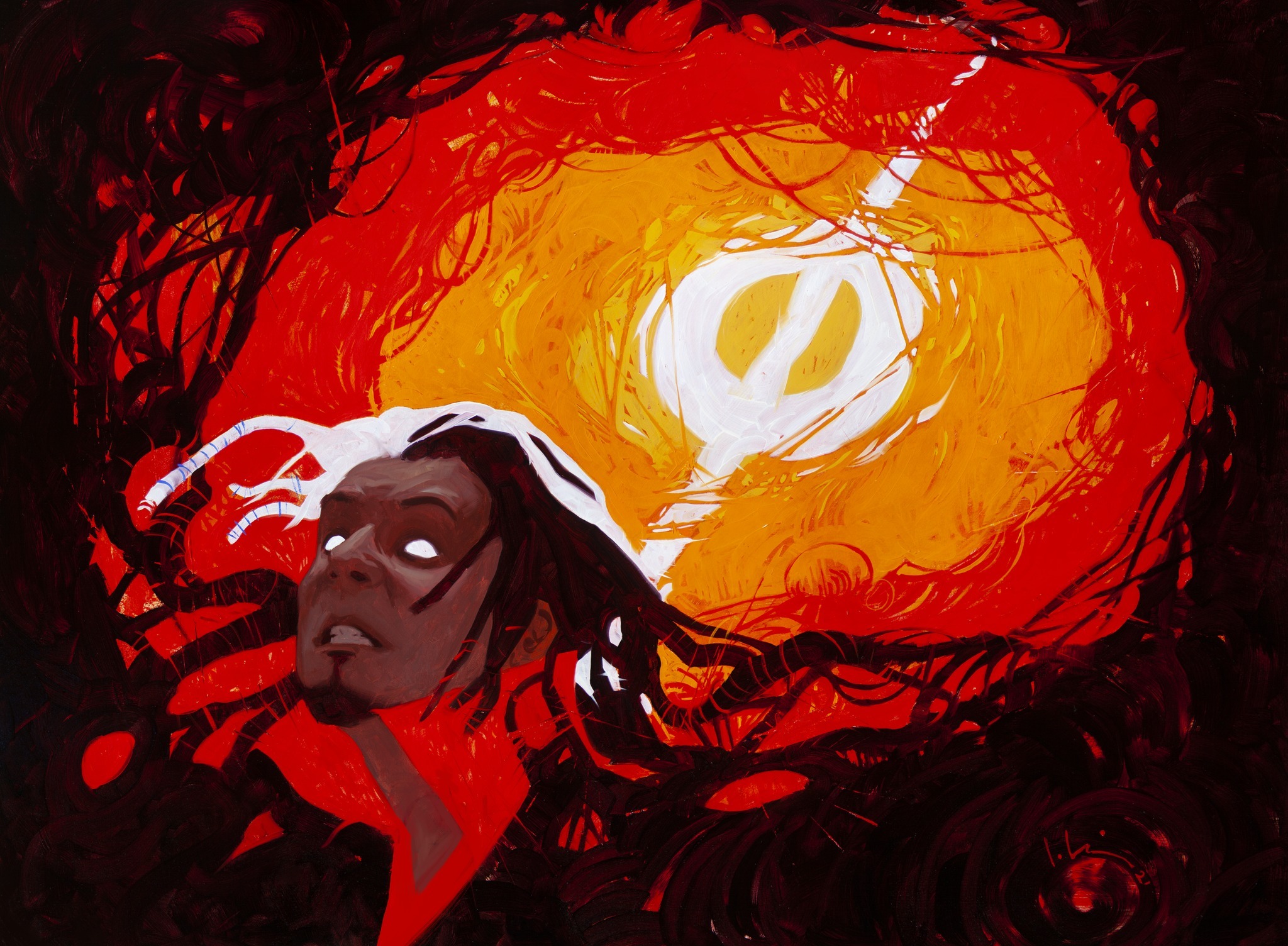
Dreams of Steel and Oil by Jeremy Wilson, oil on panel, 18” x 24”
Staying in the storytelling abstract, Jeremy Wilson has captured one of Mishra’s darkest Dreams of Steel and Oil in oils, as we see the brother who fell to Gix begin his descent into madness. There is so much power in the diagonal, beginning with Mishra and terminating into the Phyrexian sigil, surrounded by blackness, fire and flame. It’s a story snapshot that is the genesis of Mishra’s fate, and a hugely important piece of this story.
Rootpath Purifier by Justyna Dura
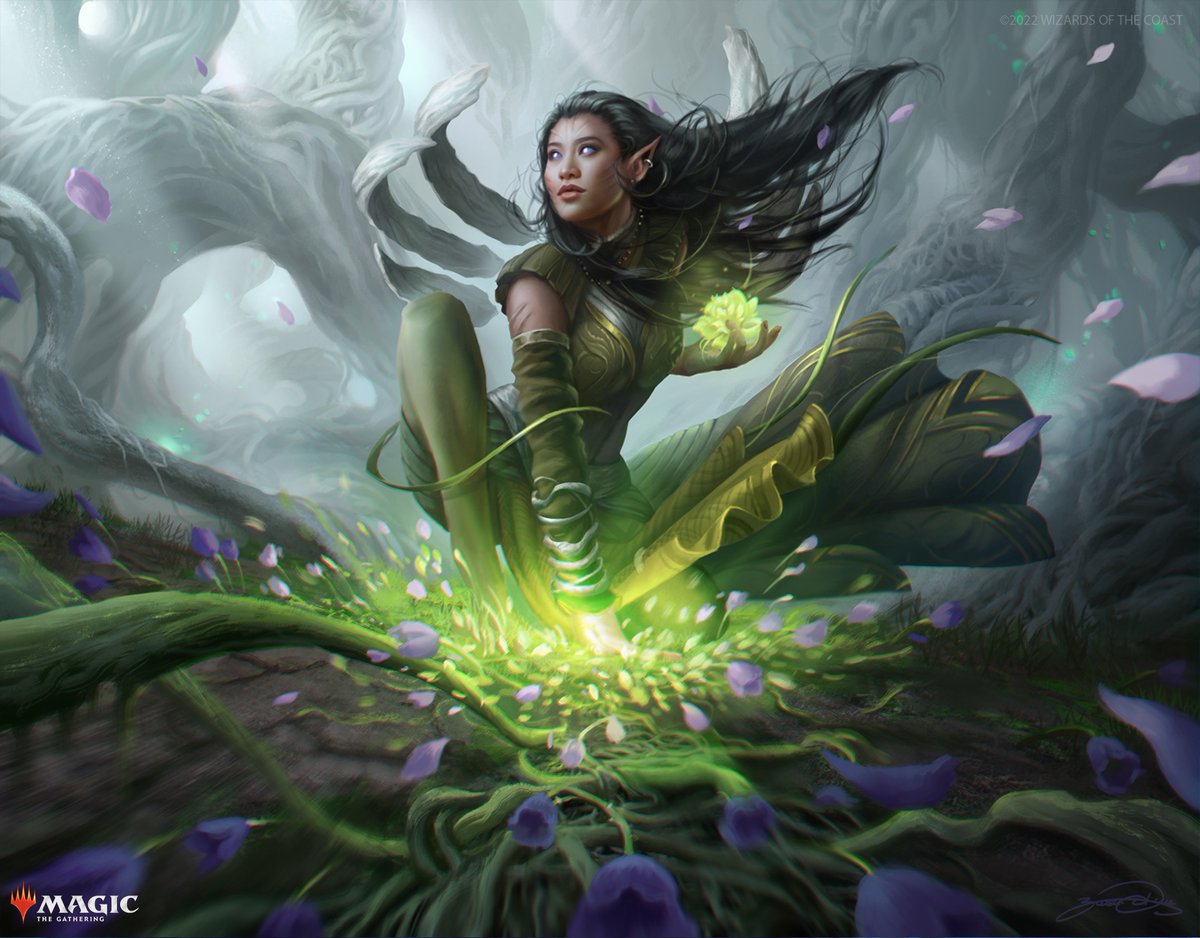
Rootpath Purifier by Justyna Dura. Digital.
Justyna Dura returns to the Grand Art Tour with her newest piece for this set, the soon to be Commander staple Rootpath Purifier. While it may be hard to see at card size, this artwork works from background to foreground; a monochrome forest turns into a glowing green figure, and from her fingertips literally explodes a verdancy that seeks to envelop the entire piece. You can almost feel a whoosh as you look upon this work, and that newness of life breaks through the card frame right in front of you.
Arcane Proxy & Steel Exemplar by Kekai Kotaki
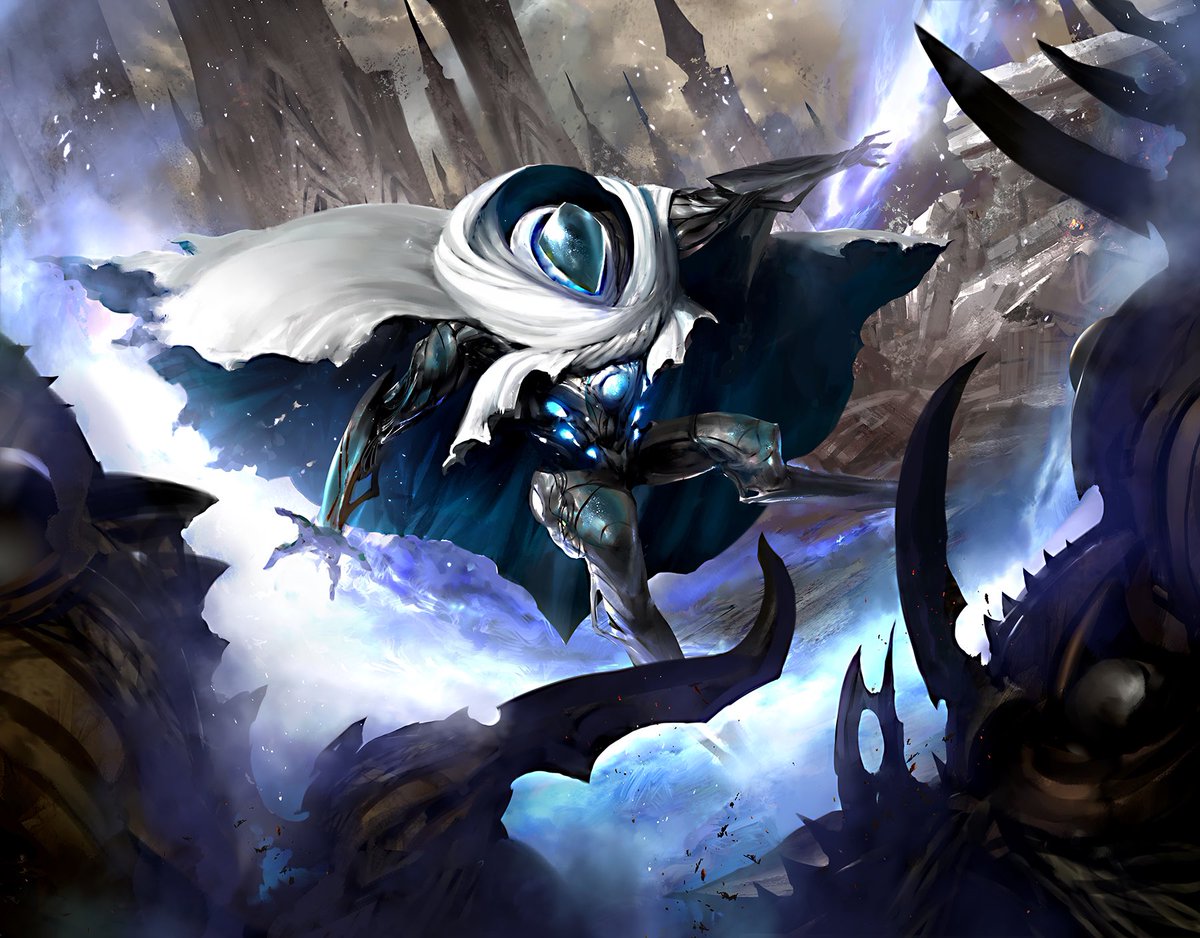
Arcane Proxy by Kekai Kotaki. Digital.
When Arcane Proxy was shown on screen at The Brothers’ War Preview Panel at Magic30 in Las Vegas, I watched my convention co-pilot Zach Barash get little-kid excited, and I did too! A mech in a cape?! How fun!
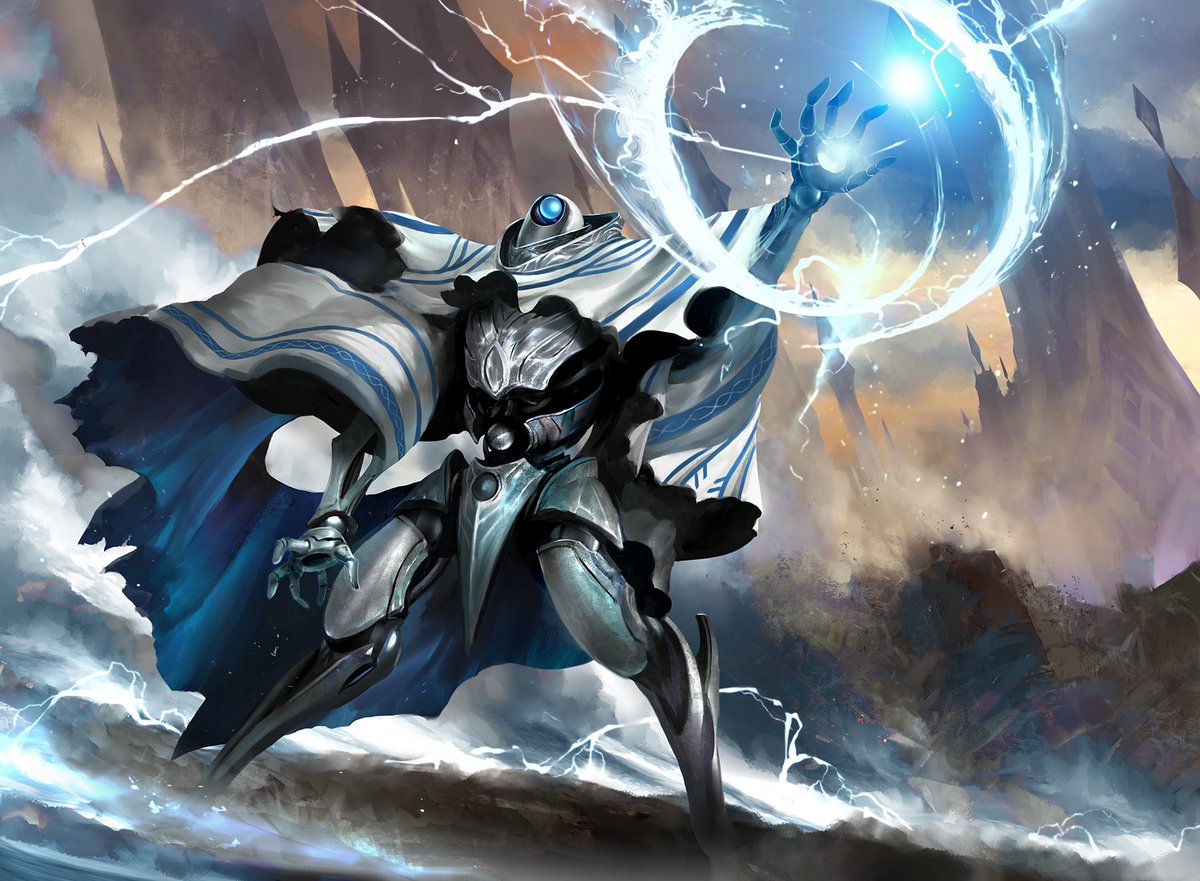
Steel Exemplar by Kekai Kotaki. Digital.
In a world writhing with larger than life robots and all matter of automata, this pair by Kekai Kotaki are just a little different. The cloak adds a wisdom-fueled, humanizing aura to the otherwise metallic method men, and it makes them wholly unique in their own design.
Ashnod, Flesh Mechanist by Howard Lyon
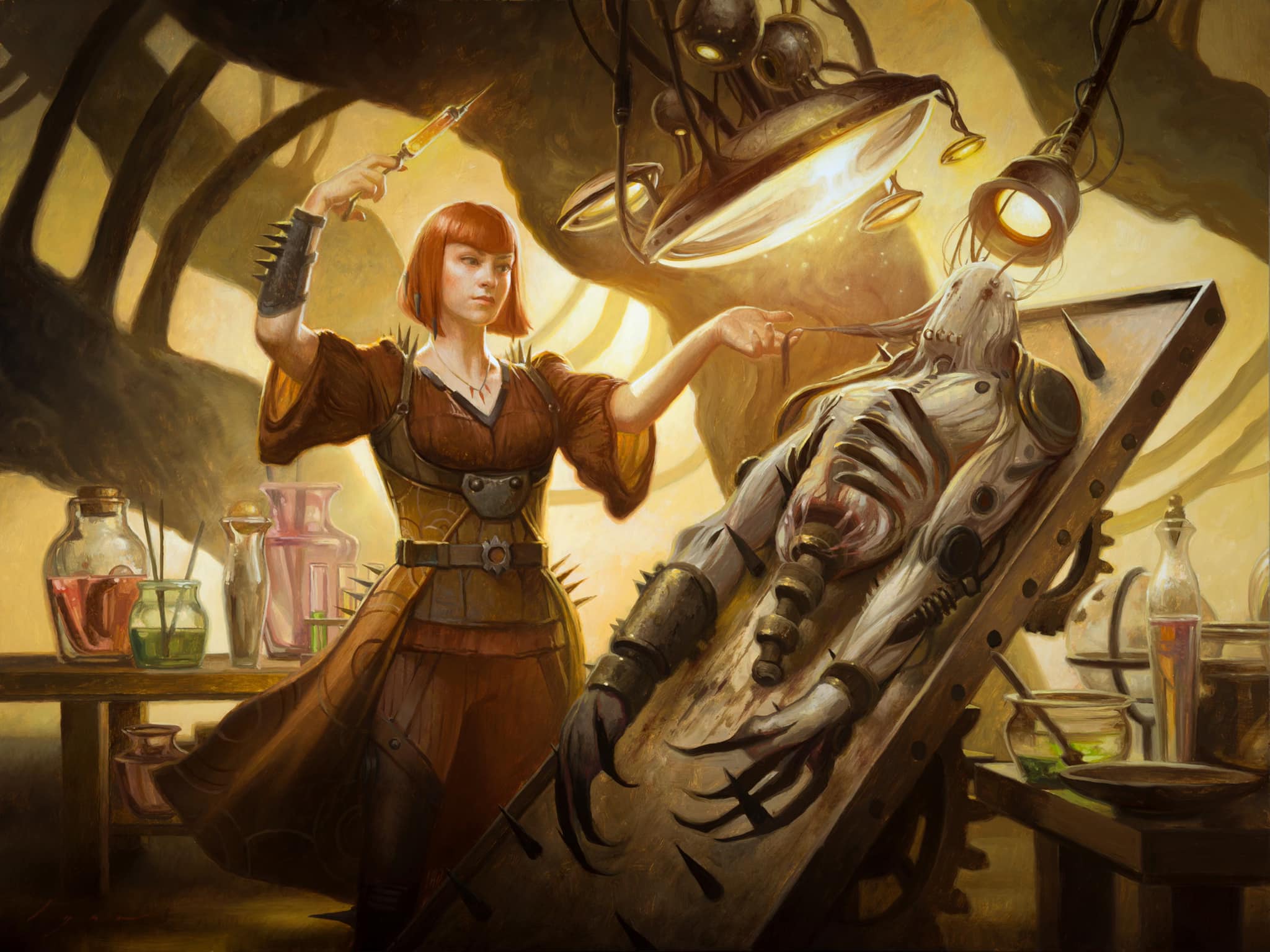
Ashnod, Flesh Mechanist by Howard Lyon, oil on panel, 12” x 16”
Howard Lyon illustrated two cards in The Brothers’ War, and Ashnod, Flesh Mechanist uses his wife Shari as reference to become Mishra’s apprentice and one of the most important figures of the war. Lyon’s figure work is unparalleled, and bathed in yellow light, creates an eerie yet confident depiction of the powerful artificer. It’s another example of imbuing a classical composition into contemporary fantasy, and I could write an article all it’s own on just what we see here. Lyon always goes to the next level, and we see that here, no doubt.
Urza and Mishra (Diptych) by Donato Giancola
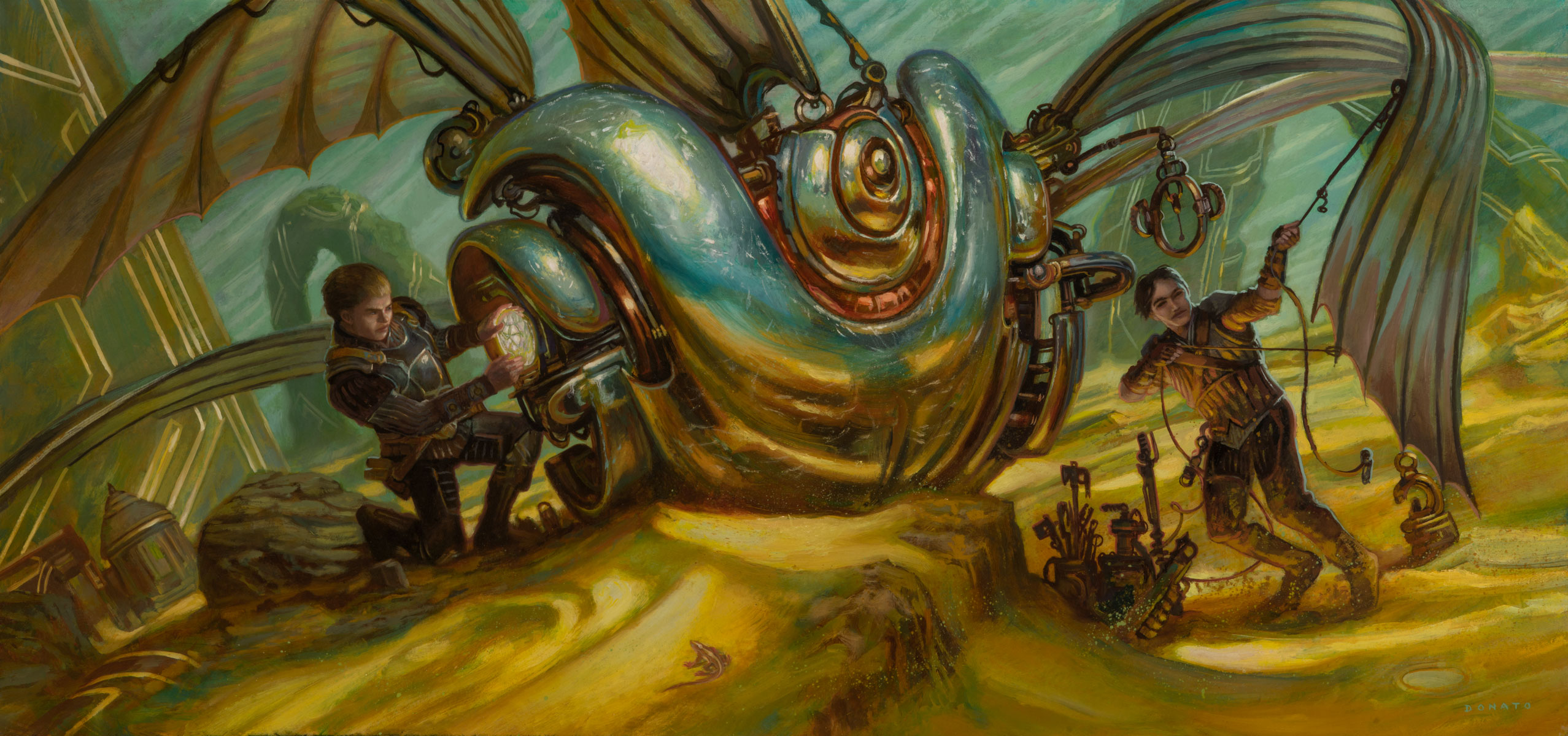
The Brothers (Diptych) by Donato Giancola, oil on panel, 12” x 26”
The Brothers’ War Grand Art Tour would not be complete without the brothers themselves, and they’ve been illustrated in their youth by none other than Donato Giancola. Painted as a single work and the card split into a diptych, the boys do what each does best under the shade of an ancient Thran thopter. Donato has captured the essence of each boy toiling away in the desert, and yet having them be united, a union in one painting later fractured, ties the entire story together. What once was one is one again, even if only for a moment.
Wrapping Up
We’ve reached the finale of this first piece examining The Brothers’ War, and all the short stories found within single cards that seek to tell the taller tale of Urza and Mishra. I wasn’t playing Magic when this story was first told in the 1990s, so it’s been especially fun to get to discover these characters and unearth these side stories through the modern artistic lens of this column. As I mentioned at the beginning, it’s as if every card artwork tells a tiny piece of an extremely large mosaic, and I think we’ll see it continue to expand through these next few sets in the story arc.
If you felt like something was missing, you’re not wrong, but as per usual there were several planned exclusions in this article. Next time we’ll hear directly from Dominik Mayer (and his Art Director Taylor Ingvarsson) about his six fantastic works in this set, and a feature on the schematic showcase cards of BRO will run in my quarterly spot on Star City Games before the end of the year. And, if time allows, I’ll return to my 4D subseries to talk about the Three Acts plus a bit of a bonus I discovered while working on this article, so stay tuned for that.
Remember, to see original #mtgart and other #vorthos related things, follow me on Twitter. Feel free to ask questions or retweet to continue the conversation. Thanks and see you next time!
Donny Caltrider (he/him) is a Senior Writer at Hipsters of Coast writing about all things related to the art of Magic: The Gathering and the larger imaginative realism genre. He has an M.A. in Museum Studies from Johns Hopkins University and enjoys telling stories about art, objects, and the intersection of fantasy with real-life. When he’s not writing for Hipsters, you can find him traveling with his wife, petting his two cats, and watching the Baltimore Orioles.

